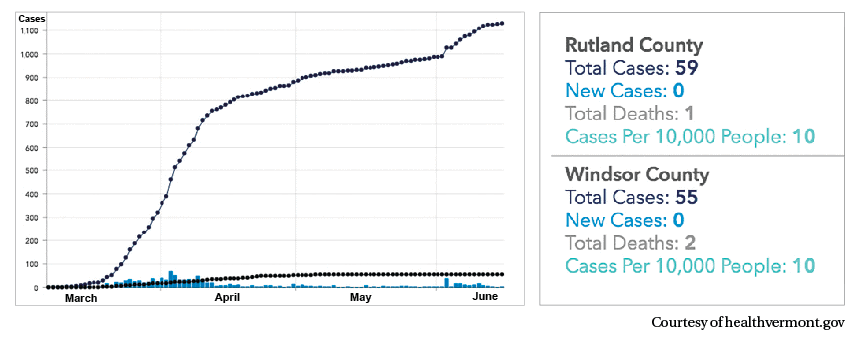
On Monday, June 15, Governor Phil Scott signed an executive order to update and extend the state of emergency in Vermont to July 15. He emphasized that the intent of the order was as “a vehicle or mechanism to do all the things we need to do to manage our response.”
Scott noted that the state of emergency was not to be confused with his “Stay Home, Stay Safe” order, which was in effect March 24 until May 15, when it became “Be Smart, Stay Safe.” Scott said all sections of the economy are now at least partially open and he will continue to relax mitigation orders as data and guidance from health experts indicate it is safe to do.
Campgrounds, he said, can operate at 100% capacity as of this week.
As of Monday, June 15, the state reported 1,128 total cases of Covid-19, with two people currently hospitalized for the virus. The death count remains at 55, a number that has not increased in “well over two weeks,” Health Commissioner Dr. Mark Levine noted. The state is averaging 1,364 Covid-19 tests per day and the low positivity rate continues. In total, the state has tested 52,557 people for Covid-19.
This and other data and modeling shows overall spread of Covid-19 continues to be limited, even as the state has seen an isolated outbreak with 84 related cases in the Winooski area.
Scott also detailed how a robust testing and tracing program; better knowledge of the virus; greater public awareness of, and adherence to, preventive measures; health and safety requirements across sectors; and increased stock of critical healthcare supplies, the state is much better positioned to track, manage and box in outbreaks and slow spread, which is critical to managing this virus until there is a vaccine.
“Each of these things demonstrates why we’ve been able to slowly reopen and lift restrictions, and why when we see outbreaks like in Winooski, it doesn’t necessarily require the same drastic actions we had to take in March,” said Governor Scott. “At the same time, we have to stay smart here at home, and we have to remember Vermont is not an island and this isn’t over.”
The governor noted that with about 130,000 active cases within a five-hour drive of Vermont, caution is still warranted, but that the state has most sectors open to some capacity and has incrementally eased restrictions on activities.
The updated order outlines the health and safety requirements and restrictions that remain in place, while authorizing the continued incremental reopening of sectors under the guidance of the Vermont Dept. of Health.
“I know that with every move we make, some believe it’s way too much, too fast and others believe it’s way too little and too slow. I hear and understand the concerns on both sides but there are no easy answers or simple solutions and there is certainly no road map,” added the governor. “So, we’ll continue to move forward under the guidance of our health experts and based on the trends we’re seeing both in Vermont and around us. If we get everything open in the right way and continue to test and trace to fight outbreaks, then we won’t have to retreat, which will be better for the economy and our quality of life in the long term.”
The state of emergency declaration is necessary to continue to manage and respond to this public health crisis, the governor explained. It gives the state the ability to activate numerous tools for response efforts, including protection for residents of long-term and other medical facilities, licensing and regulatory flexibility to facilitate response efforts, health and safety requirements, federal emergency funding, and expanded access to needed services like housing, meal delivery and unemployment insurance.
“I know this has felt like a long journey already… and so much uncertainty remains. But if we continue to stay smart, committed to each other… and, above all else, united together in this fight…… we WILL get through this,” concluded Governor Scott.



